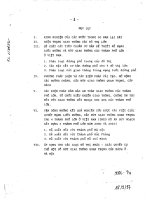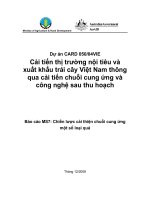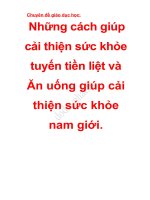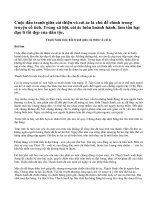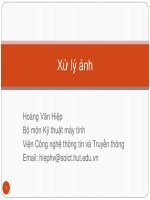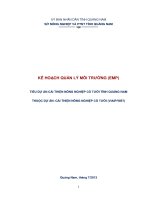USING QUIZZES TO IMPROVE VOCABULARY OF THE 6TH GRADE STUDENTS AT HOANG NGAN SECONDARY SCHOOL, DINH HOA, THAI NGUYEN (SỬ DỤNG QUIZZES ĐỂ CẢI THIỆN TỪ VỰNG CỦA HỌC SINH LỚP 6 TRƯỜNG THCS HOÀNG NGÂN, ĐỊNH HÓA, THÁI NGUYÊN)
Bạn đang xem bản rút gọn của tài liệu. Xem và tải ngay bản đầy đủ của tài liệu tại đây (546.14 KB, 105 trang )
VIET NAM NATIONAL UNIVERSITY OF AGRICULTURE
FACULTY OF TOURISM AND FOREIGN LANGUAGES
BA THESIS
USING QUIZZES TO IMPROVE VOCABULARY OF
THE 6TH GRADE STUDENTS AT HOANG NGAN
SECONDARY SCHOOL, DINH HOA, THAI NGUYEN
(SỬ DỤNG QUIZZES ĐỂ CẢI THIỆN TỪ VỰNG CỦA
HỌC SINH LỚP 6 TRƯỜNG THCS HỒNG NGÂN,
ĐỊNH HĨA, THÁI NGUN)
Student: Dinh Hong Ngoc
Student code: 645616
Major: English
Supervisor: Tran Thu Trang, M.A
Hanoi - 2023
CERTIFICATE OF ORIGINALITY
I, the undersigned, hereby certify my authority of the study project report
entitled “Using Quizzes to improve vocabulary for 6th grade students at
Hoang Ngan Secondary School, Dinh Hoa, Thai Nguyen"submitted in partial
fulfillment of the requirements for the degree of Bachelor in English Language.
Except where the reference is indicated, no other person’s work has been used
without due acknowledgement in the text of the thesis.
Hanoi, 2023
Dinh Hong Ngoc
Approved by
SUPERVISOR
(Signature and full name)
Date:……………………
ABSTRACT
The purpose of this study is to investigate if the use of Quizzes can
improve vocabulary skills of 6th grade students at Hoang Ngan Secondary
School, Dinh Hoa district, Thai Nguyen. The number of study participants
included 84 students from grades 6A and 6B of Hoang Ngan Secondary School.
Within 3 months of classroom activity research, the method that was used to
teach vocabulary to 6th graders was the action research method. Research tools
are tests, questionnaires. The pre-test and post-test were used to assess the
students' English vocabulary ability before and after the study, respectively. The
questionnaire was also used to assess the participants' development of
receptivity during class time as well as their attitudes towards Quizzes. The
results of the following test revealed that the participants significantly increased
their vocabulary using Quizzes for 3 months. Data from the questionnaire shows
that students have a positive attitude towards Quizzes activities because they
find them more enjoyable and comfortable. They also look forward to having
more modes of learning in the future. Activities that increase interest, comfort,
relaxation and do not feel pressured when learning vocabulary. Research also
shows that students expect teachers to regularly apply newer methods in
teaching and learning.
TABLE OF CONTENTS
FACULTY OF TOURISM AND FOREIGN LANGUAGES...............................i
CERTIFICATE OF ORIGINALITY.....................................................................i
ABSTRACT..........................................................................................................ii
TABLE OF CONTENTS.....................................................................................iii
LIST OF TABLES AND FIGURES....................................................................vi
LIST OF CHARTS............................................................................................viii
PART I: INTRODUCTION.................................................................................1
1. RATIONALE FOR THE STUDY................................................................1
2. AIMS AND OBJECTIVES OF THE STUDY...............................................3
3. RESEARCH QUESTIONS............................................................................3
4. SCOPE OF THE STUDY..............................................................................3
5. SIGNIFICANCE OF THE STUDY...............................................................4
6. DESIGN OF THE STUDY............................................................................4
PART II. DEVELOPMENT..................................................................................6
CHAPTER 1: LITERATURE REVIEW...............................................................6
1.1. REVIEW OF PREVIOUS STUDIES.......................................................6
1.1.1. At home..............................................................................................6
1.1.2. Abroad................................................................................................7
1.2. REVIEW OF THEORETICAL BACKGROUND...................................9
1.2.1. Vocabulary............................................................................................9
1.2.1.1. Definition of Vocabulary...................................................................9
1.2.1.2. The importance of vocabulary in English..........................................9
1.2.1.3. Teaching vocabulary........................................................................10
1.2.2. Quizzes................................................................................................15
1.2.2.1. Definition of Quizzes.......................................................................15
1.2.2.2. Applying Quizzes in teaching..........................................................15
1.2.3. The relationship between Quizzes and vocabulary learning...............17
1.3. VOCABULARY DEVELOPMENT FACTORS...................................18
1.3.1 Persistence............................................................................................18
1.3.2. Study plan............................................................................................19
1.3.3. References...........................................................................................19
1.3.4. Practical application............................................................................20
CHAPTER 2: METHODOLOGY.......................................................................21
2.1. ACTION RESEARCH............................................................................21
2.1.1. Definition of the action research.........................................................21
2.1.2. The reasons for choosing action research...........................................22
2.1.3. The procedures of action research.......................................................22
2.2. RESEARCH SETTING..........................................................................24
2.3
RESEARCH PROCEDURES.................................................................24
2.3.1. Planning...............................................................................................25
2.3.2. Action..................................................................................................25
2.3.3. Observation.........................................................................................26
2.3.4. Reflection............................................................................................26
2.4. DATA COLLECTING INSTRUMENTS..............................................26
2.4.1. Test......................................................................................................26
2.4.2. Questionnaire......................................................................................27
CHAPTER 3: FINDINGS AND DISCUSSION.................................................29
3.1. THE RESEARCH FINDINGS...............................................................29
3.1.1. Findings from pre-test and post-test....................................................29
3.1.2. Findings from pre-questionnaires and post questionnaires.................32
3.1.2.1. Vocabulary learning status of 6th grade students at Hoang Ngan
Secondary School..........................................................................................32
3.1.2.2. Positive evaluations on the effects of Quizzes.................................45
3.2. DISCUSSION.........................................................................................60
PART III. CONCLUSION AND SUGGESTION..............................................62
1. CONLUSION.............................................................................................62
2. LIMITATION OF THE STUDY...............................................................63
3. SUGGESTIONS FOR FURTHER STUDY..............................................64
REFERENCES....................................................................................................65
APPENDIX 1A: ( English -Vietnamese version )..............................................68
APPENDIX 1B: ( English -Vietnamese version )...............................................70
APPENDIX 2A: PRE-TEST...............................................................................75
APPENDIX 2B: POST-TEST.............................................................................78
APPENDIX 3: SUMMARY OF TEST DATA...................................................81
APPENDIX 4: DATA OBTAINAED BY PRE-QUESTIONNAIRES..............82
APPENDIX 5: DATA OBTAINAED BY POST-QUESTIONNAIRES............83
APPENDIX 6:.....................................................................................................84
LIST OF TABLES AND FIGURES
Figure 1.1. Illustration for configuring the formula multiple choice..................15
Figure 2.1. The AR Model Developed by Kemmis and McTaggart (1998).......23
Table 2.1. Schedule of vocabulary lessons for study..........................................25
Table 2.2. Criteria for test results classification..................................................27
Table 3.1. Summary of test data..........................................................................29
Table 3.2. Descriptive Statistics of pre-test and post-test...................................31
Table 3.3. Data results of pre-questionnaire and post-questionnaire of question 1
.............................................................................................................................32
Table 3.4. Data results of pre-questionnaire and post-questionnaire of question 2
.............................................................................................................................33
Table 3.5. Data results of pre-questionnaire and post-questionnaire of question 3
.............................................................................................................................34
Table 3.6. Data results of pre-questionnaire and post-questionnaire of question 4
.............................................................................................................................35
Table 3.7. Data results of pre-questionnaire and post-questionnaire of question 5
.............................................................................................................................35
Table 3.8. Data results of pre-questionnaire and post-questionnaire of question 6
.............................................................................................................................36
Table 3.9. Data results of pre-questionnaire and post-questionnaire of question 7
.............................................................................................................................37
Table 3.10. Data results of pre-questionnaire and post-questionnaire of question
8...........................................................................................................................38
Table 3.11. Data results of pre-questionnaire and post-questionnaire of question
9...........................................................................................................................39
Table 3.12. Data results of pre-questionnaire and post-questionnaire of question
10.........................................................................................................................40
Table 3.13. Data results of pre-questionnaire and post-questionnaire of question
11.........................................................................................................................41
Table 3.14. Data results of pre-questionnaire and post-questionnaire of question
12.........................................................................................................................42
Table 3.15. Data results of pre-questionnaire and post-questionnaire of question
13.........................................................................................................................43
Table 3.16. Data results of pre-questionnaire and post-questionnaire of question
14.........................................................................................................................44
Table 3.17. Data of post-questionnaire of question 15........................................45
Table 3.18. Data of post-questionnaire of question 16........................................46
Table 3.19. Data of post-questionnaire of question 17........................................47
Table 3.20. Data of post-questionnaire of question 18........................................48
Table 3.21. Data of post-questionnaire of question 19........................................49
Table 3.22. Data of post-questionnaire of question 20........................................50
Table 3.23. Data of post-questionnaire of question 21........................................51
Table 3.24. Data of post-questionnaire of question 22........................................52
Table 3.25. Data of post-questionnaire of question 23........................................53
Table 3.26. Data of post-questionnaire of question 24........................................54
Table 3.27. Data of post-questionnaire of question 25........................................55
Table 3.28. Data of post-questionnaire of question 26........................................56
Table 3.29. Data of post-questionnaire of question 27........................................57
Table 3.30. Data of post-questionnaire of question 28........................................58
Table 3.31. Data of post-questionnaire of question 29........................................59
LIST OF CHARTS
Chart 3.1. Compare test score percentages..........................................................30
Chart 3.2. Display chart of table 3.3....................................................................32
Chart 3.3. Display chart of table 3.4....................................................................33
Chart 3.4. Display chart of table 3.5....................................................................34
Chart 3.5. Display chart of table 3.6....................................................................35
Chart 3.6. Display chart of table 3.7....................................................................36
Chart 3.7. Display chart of table 3.8....................................................................37
Chart 3.8. Display chart of table 3.9....................................................................38
Chart 3.9. Display chart of table 3.10..................................................................39
Chart 3.10. Display chart of table 3.11................................................................40
Chart 3.11. Display chart of table 3.12................................................................41
Chart 3.12. Display chart of table 3.13................................................................42
Chart 3.13. Display chart of table 3.14................................................................43
Chart 3.14. Display chart of table 3.15................................................................44
Chart 3.15. Display chart of table 3.16................................................................45
Chart 3.16. Display chart of table 3.17................................................................46
Chart 3.17. Display chart of table 3.18................................................................47
Chart 3.18. Display chart of table 3.19................................................................48
Chart 3.19. Display chart of table 3.20................................................................49
Chart 3.20. Display chart of table 3.21................................................................50
Chart 3.21. Display chart of table 3.22................................................................51
Chart 3.22. Display chart of table 3.23................................................................52
Chart 3.23. Display chart of table 3.24................................................................53
Chart 3.24. Display chart of table 3.25................................................................54
Chart 3.25. Display chart of table 3.26................................................................55
Chart 3.26. Display chart of table 3.27................................................................56
Chart 3.27. Display chart of table 3.28................................................................57
Chart 3.28. Display chart of table 3.29................................................................58
Chart 3.29. Display chart of table 3.30................................................................59
Chart 3.30. Display chart of table 3.31................................................................60
PART I: INTRODUCTION
1. RATIONALE FOR THE STUDY
Nowadays, English is the common language used in most of the countries.
So it's no surprise that English has become an important subject. To learn
English well, knowing a lot of vocabulary is indispensable. Because of their
young ages, students just do not aware of the importance of learning English as
a mandatory subject and some of them simply study in order to pass the exams
successfully. In an objective way, there are still many obstacles for both learning
English methods and the way teachers impart their knowledge to the students.
With the traditional teaching method of today's high schools, it is likely that
students will be bored and not interested in learning English. Therefore,
improving the quality of teaching is an issue that many teachers are aiming for,
but not all teaching methods are suitable for students. With the teaching method
(CLT), in order for students to be good at all four skills of listening, speaking,
reading and writing, it is important and necessary to acquire a lot of vocabulary.
In addition, vocabulary is reviewed as the most significant building block of
language acquisition (Bai, 2018; Nie & Zhou, 2017; Nurdiansyah, Asyid, &
Parmawati, 2019), since vocabulary is the root and basis for language
development. Many studies show that using quizzes is a good learning method
to improve students' vocabulary. Theobald and Danforth (2021) have proven
that using quizzes helps students improve vocabulary quickly and effectively.
Besides, the use of quizzes also helps to increase the interaction and
participation of students in the learning process.
Technology has become an important part of education and plays an
important role in enhancing interaction and stimulating learning. Using
technology in education has been confirmed by many studies to be effective.
According to Lai and Burrell (2016), technology can help improve the quality of
education and increase interactivity in the classroom. In addition, using
technology also helps increase student interest and engagement in the learning
process.
Technology has become an important part of education and plays an
important role in enhancing interaction and stimulating learning. Using
technology in education has been confirmed by many studies to be effective.
According to Lai and Burrell (2016), technology can help improve the quality of
education and increase interactivity in the classroom. In addition, the use of
technology also helps increase student interest and involvement in the learning
process. Menon and Varughese (2020) argue that using technology helps
students increase their access to rich vocabulary resources, while helping
students learn vocabulary more effectively through interactive activities. and
online games. Besides, Dai and Chen (2019) studied the use of online games to
learn vocabulary and concluded that using games helps students learn and
memorize words. vocabulary more effectively. It was because of the researchers'
comments that I learned about Quizzes.
The author is currently a student majoring in English, having experience
in teaching at educational institutions, so I see that the current students'
vocabulary is limited. Specifically, after a month of practice at Hoang Ngan
Secondary School, the author realized more clearly the lack of vocabulary in
students' English use. This is an undeveloped unit in terms of environment
where English is used a lot, the use of English in daily communication is not
high, so students are not active in using vocabulary. With the association with
Hoang Ngan Secondary School for 4 years, I realize that the traditional teaching
method at the school has not brought much progress in the students' use of
English. Ali and Rosli (2019) explain that to maximize learning outcomes, it is
essential to choose a teaching delivery method that emphasizes the effectiveness
of interactive learning. Therefore, I want to find a solution to help students here
improve their vocabulary, create interest in learning and increase interaction in
the classroom.
All of the above reasons and factors have inspired me to conduct research
in order to improve vocabulary for students at Hoang Ngan Secondary School
better and better, I decided to conduct a research: “Using Quizzes to improve
vocabulary for 6th grade students at Hoang Ngan Secondary School, Dinh Hoa,
Thai Nguyen". Hopefully this research can help teachers in teaching vocabulary
for students, especially amateur students in the class.
All of the above reasons and factors have inspired me to conduct research
in order to improve vocabulary for students at Hoang Ngan Secondary School
better and better, I decided to conduct a research: “Using Quizzes to improve
vocabulary for 6th grade students at Hoang Ngan Secondary School, Dinh
Hoa, Thai Nguyen". Hopefully this research can help teachers in teaching
vocabulary for students, especially amateur students in the class.
2. AIMS AND OBJECTIVES OF THE STUDY
The main aim of this research is to find out the effectiveness of Quizzes to
improve vocabulary of the 6th grade students at Hoang Ngan Secondary School.
This overall goal is coneretized into the following objectives:
Firstly, to investigate the reality of learning vocabulary of 6th grade
students at Hoang Ngan Secondary School.
Secondly, to investigate the effectiveness of using Quizzes to improve
vocabulary for 6th graders at Hoang Ngan secondary school.
3. RESEARCH QUESTIONS
To achieve the above aim of the study, the following questions was
raised:
To what extent can Quizzes affect students' vocabulary?
4. SCOPE OF THE STUDY
Due to the limited time, resources and knowledge as well as the large
number of students, I only focused on surveying 6th grade students at Hoang
Ngan Secondary School. Specifically, at the school, there are currently two
classes 6A and 6B, a total of 84 students are studying at Hoang Ngan Secondary
School.
The study period is from February 12, 2023 to May 18, 2023 (Term 2, academic
year 2022-2023).
The textbook used is "English 6 i-learning Smart World" edited by Vo Dai Phuc
and published by Ho Chi Minh City University of Education. This is a book in
the latest 8 English 6 textbooks for 2021-2022.
5. SIGNIFICANCE OF THE STUDY
According to Rohmatullah has said that learning vocabulary is very
important for English learners. It serves as the foundation for the development
of all skills. At the same time, Heubener (1965:88) states that vocabulary
learning is based on the formation of specific habits. Therefore, vocabulary
helps learners to apply flexibly and diverse words when speaking, writing and in
the process of listening and reading comprehension, which will help learners
practice more fluently.
In a developing society, learning English or learning a new foreign
language is an indispensable development step. Especially in Vietnam, it is
essential to learn English at a time when Vietnamese education encourages
initiative, thinking and creativity. During the research, the author found that
students often have difficulty speaking, they feel that using English to
communicate is very tiring, in addition, the use of words to communicate is also
limited. varied in word usage. From here, the author realizes that vocabulary is
an extremely important aspect of words. A large vocabulary will help learners
easily express their wishes.
The author hopes that this study will help students' English learning
process and innovate teaching methods of English teachers. Especially in the
process of improving vocabulary.
6. DESIGN OF THE STUDY
This is a description survey will be conducted for a survey 6th grade
students at Hoang Ngan Secondary School by applying Quizzes to improve
vocabulary skills. The research structure will be divided into 3 main parts:
Part I: INTRODUCTION indicates the rationale, the aim and objectives, the
scope, the significance and the design of the study.
Part II: DEVELOPMENT is divided into 3 chapters:
Chapter 1: LITERATURE REVIEW – provides theoritical background for the
study including definition of vocabulary, definition of Quizzes,...
Chapter 2: METHODOLOGY describes the methodology used in the research
including research methodology, research setting/context, data collection and
data analysis.
Chapter 3: FINDINGS AND DISCUSSIONS – reports and discusses the
findings of the study.
Part III: CONCLUSION summarizes the main issues that have been addressed
in the study, points out the limitations, make some suggestions about the study.
PART II. DEVELOPMENT
CHAPTER 1: LITERATURE REVIEW
This chapter consists of two parts: Section 1.1 presents an overview of
previous research related studies in the world and in Vietnam; and Section 2.2
presents the theoretical basis such as the main concepts of vocabulary definition,
definition of Quizzes, importance of vocabulary in English and relationship
between Quizzes and vocabulary learning.
1.1.
REVIEW OF PREVIOUS STUDIES
1.1.1. At home
Pham Thi Hoai, Vo Thi Xuan Anh, Huynh Thanh Thanh at Van Lang
University, Vietnam has conducted the study: “The application of Quizizz game
on mobile phones of students in English classes at school Study Van Lang
”(2021). The purpose of the study is to examine students' reactions to the
implementation of the Quizzes game directly on mobile phones during English
lessons and its influence on learners. The subject was studied as 90 amateur
students at Van Lang University. Interview methods and questionnaires are used
in research. The interview was made over 30 participants and the questionnaire
was sent to 90 participants. Conclusion obtained by the author after the study is
as follows: The use of Quizzes on mobile phones during English lessons has
brought a positive learning spirit for students and students to show a positive
attitude to the opposite attitude. With Quizzes game in the classroom. At the
same time, the source of creativity in the teaching process of teachers.
Ngo Thi Bich Ngoc, Tran Thi Nam Phuong at the Faculty of Foreign
Languages, Thai Nguyen University of Education also studied together on the
topic: "Application of quizizz game in memorizing vocabulary of non-English
major students. : A case study at Thai Nguyen University of Education” (2022).
The study was conducted to investigate the effect of Quizzes game in facilitating
students' vocabulary memorization and students' attitude towards using Quizzes
game in vocabulary learning. The object of the research is non-English majors,
so the English-speaking environment will be limited, and at the Thai Nguyen
University of Pedagogy, there are many different disciplines, so the vocabulary
will be limited. very diverse and rich. The study was experimented in the first
semester of the school year 2021-2022 with 82 students participating in the
control group and the experimental group. The research methods used here are
tests and questionnaires, to obtain the best results, the author has divided the
stages of pre-test and post-test, with the author's questionnaire divided by
distribution after the study period. The result of this study is that students'
vocabulary learning is significantly improved, besides, learners will increase
their ability to memorize vocabulary and make learning more motivated. From
the application of Quizzes to teaching and learning in learning English
vocabulary, it has created excitement for students and minimized boredom when
doing assignments. Since then, the frequency of students learning English has
increased.
1.1.2. Abroad
Law Szee Huei, Melor MD Yunus, Harwati Hashim at the Faculty of
Education, University of Kebangsaan Malaysia, Malaysia jointly researched the
issue of "Strategies to improve English vocabulary achievement during the
CoVID-19 epidemic". (2021). The aim of this study was to use Quizzes to
improve the vocabulary achievement of primary school students learning
English as a Second Language (ESL) in rural schools. In the study, mixed
methods were used with purposeful sampling of 13 participants. To obtain the
best results, the author collected data both before and after the experiment
according to the researcher's Likert scale and design questionnaire. Data were
analyzed using appropriate quantitative analysis. To study more accurately, the
researchers used the interview method. The result of the research is that Quizzes
are a fun learning method for learners, the features in Quizzes tend to create a
positive learning atmosphere. From this, it can be concluded that Quizzes can
improve the vocabulary achievement of primary school students learning
English as a Second Language (ESL) in rural schools.
Maria Dimitrij Angie Pavita, Deli Nirmala at the Department of
Linguistics, Faculty of Humanities, University of Dipegoro worked together on
research on the issue of "Merdeka belajar during a pandemic: Using Quizizz
game-based learning to improve learning students' vocabulary mastery" (2021).
The stated purpose of this study is to improve students' vocabulary mastery
through Quizzes. This is an action research project and is carried out at Sma
Bruderan Purwokerto. The study subjects were 26 students of X MIPA 1. The
study was carried out in two cycles. The steps in research are planning, acting,
observing, and reflecting. The result obtained from this study is to improve the
cognitive ability, improve the emotional factors of learners. Specifically, when
analyzing the results, the author found that the average difference in test scores
before doing the study was from about 64/100 and after doing the research from
about 85/100. This shows that the joy of learning supported their ability to
memorize easily. Quizzes can be one of the learning mediums that make
students more interested in learning English, especially vocabulary because
students can memorize and receive new vocabulary more easily.
According to researcher Samet Bal in Turkey, he studied the problem of
"Using Quizizz.com to improve the vocabulary knowledge of pre-secondary
students" (2018). This study was conducted with the aim of investigating the
relationship between mobile apps and vocabulary learning. In this study, 60
students studying at a university in Turkey were divided into two groups and
they were observed for a period of 4 weeks and an achievement test was
administered to both groups. The experimental group used an app called
“Quizziz” for these 4 weeks, and the control group continued to learn
vocabulary through traditional paper-based activities. The results from this
observation and the trial showed that the experimental experimental group had
better results than the control group.
All of the above studies are highly accurate and selected for the author to learn.
With Quizzes can be an effective form of learning to bring lesson content to
students, giving students the opportunity to practice using words in different
situations. However, none of the above studies have studied the application of
Quizzes to develop vocabulary at Hoang Ngan Secondary School, Dinh Hoa.
Therefore, the researcher decided to carry out this study.
1.2.
REVIEW OF THEORETICAL BACKGROUND
1.2.1. Vocabulary
1.2.1.1. Definition of Vocabulary
In the 1980s, scholars first argued that strategies for successful learners
could be systematized and taught to low-achieving learners, leading to increased
learning effectiveness (Rubin, J.1987). The proposed implementation is
effective by facilitating training of learners in the characteristics of the target
language, as poor language learners may apply these strategies many times
while completing exercises of the lesson (Wenden, A.1987). From there, provide
an educational method by incorporating gamification into students' vocabulary
learning.
According to Hornby (1984), vocabulary is the sum total of words, their
meanings and the rules for combining them to form language. Vocabulary
mastery is very important for foreign language learners so that they easily
develop the four language skills of speaking, listening, writing and reading
comprehension.
Thornbury
(2003)
states
that
without
grammatical
communication is possible, but without lexical communication impossible. That
means vocabulary is extremely important because vocabulary helps people
convey information, express their opinions and desires.
According to Kusrini (2012), some words that are applied and understood
by learners are considered as vocabulary. On the other hand, in the opinion of
Alizadeth (2016) vocabulary is defined as a list of words compiled from certain
alphabets with meanings. Because of the vastness of the vocabulary Sidek &
Rahim (2015) argued that “lexical knowledge” is also necessary for successful
reading.
1.2.1.2. The importance of vocabulary in English
With an extremely large and diverse vocabulary, it is possible for learners
to be worried and depressed. In addition, manual teaching methods will create
an uncomfortable mood, leading to vocabulary learning also becoming difficult
because of distractions. Berne & Blachowicz (2008) point out that teaching
vocabulary can be problematic because many teachers are not confident about
best practices in teaching vocabulary and sometimes don't know where to start
to form emphasis. strong in teaching about learn words. The lack of learning
goals will lead to a general pattern of giving up, being afraid to learn, and not
wanting to communicate. That leads to students being "poor" in vocabulary.
Schmitt (2000) emphasizes that “lexical knowledge is central to
communicative competence and to acquiring a second language”, so a limited
second language vocabulary will hinder successful communication. . The
importance of vocabulary is expressed daily in and out of school. In life, when
we have a meaning or concept that we want to express, we need an inventory of
